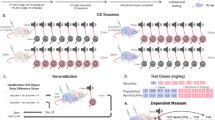Abstract
The present study assessed the discriminative stimulus effects of the delta-opioid agonist [d-Pen2-d-Pen5]enkephalin (DPDPE) in pigeons. Food-restricted pigeons were trained to discriminate between ICV injections of 100 µg [d-Pen2-d-Pen5]enkephalin (DPDPE) and saline in a two-key operant procedure; acquisition of discriminative control was rapid (14–28 daily sessions). [d-Ser2, Leu5, Thr6]enkephalin (DSLET) and [d-Ala2]deltorphin II, peptides selective for delta-opioid receptors, produced discriminative stimulus effects similar to DPDPE, and were approximately equipotent to DPDPE. The non-peptidic, delta-opioid agonist BW373U86 (0.032–100 mg/kg, IM) partially generalized to DPDPE. The kappa-opioid agonist U69,593 (0.01–1 mg/kg, IM), and the mu-opioid agonists, DAMGO (0.1–3.2 µg, ICV) and morphine (1–10 mg/kg, IM), did not produce discriminative stimulus effects similar to DPDPE, up to doses that markedly decreased response rates. Naltrindole (0.1 mg/kg, IM), an antagonist selective for deltaopioid receptors, produced approximately a 30-fold reduction in the potency of DPDPE. DPDPE's discriminative stimulus effect in pigeons appears to be mediated through a delta-opioid receptor; this effect may provide a procedure for assessing delta-opioid receptor function in vivo.
Similar content being viewed by others
References
Comer SD, McNutt RW, Chang K-J, De Costa BR, Mosberg HI, Woods JH (1993) Discriminative stimulus effects of BW373U86: a nonpeptide ligand with selectivity for delta opioid receptors. J Pharmacol Exp Ther 267:866–874
Ferster CB, Skinner BF (1957) Schedules of reinforcement. Appleton Century Crofts, New York
France CP, Adams JU, Woods JH (1985) Intracerebroventricular drug administration in pigeons. Pharmacol Biochem Behav 23:731–736
Herling S, Coales EH Jr, Valentino RJ, Hein DW, Woods JH (1980) Narcotic discrimination in pigeons. J Pharmacol Exp Ther 214:139–146
Jewett DC, Schaal DW, Cleary J, Thompson T, Levine AS (1991) The discriminative stimulus properties of neuropeptide Y. Brain Res 561:165–168
Jewett DC, Cleary J, Schaal DW, Thompson T, Levine AS (1993) [Leu31, Pro34] Neuropeptide Y (NPY), but not NPY 20–36, produces discriminative stimulus effects similar to NPY and induces food intake. Brain Res 631:129–132
Jiang Q, Mosberg HI, and Porreca F (1990) Antinociceptive effects of [d-Ala2]deltorphin II, a highly selective delta agonist in vivo. Life Sci 47:PL43-PL47
Karten HJ, Hodos W (1967) A stereotaxic atlas of the brain of the pigeon (Columba livia). Johns Hopkins Press, Baltimore
Koek W, Kleer E, Mudar PJ, Woods JH (1986) Phencyclidine-like catalepsy induced by the excitatory amino acid antagonist dl-2-amino-5-phosphonovalerate. Beh Brain Res 19:257–259
Mattia A, Vanderah T, Mosberg HI, Porreca F (1991) Lack of antinociceptive cross-tolerance between [d-Pen2-d-Pen5]enkephalin and [d-Ala2]deltorphin II in mice: evidence for delta receptor subtypes. J Pharmacol Exp Ther 258:583–587
Mosberg HI, Hurst R, Hruby VJ, Gee K, Yamamura HI, Galligan JJ, Burks TF (1983) Bis-penicillamine enkephalins possess highly improved specificity toward δ opioid receptors. Proc Natl Acad Sci USA 80:5871–5874
Negus SS, Burke TF, Medzihradsky F, Woods JH (1993) Effects of opioid agonists selective for mu, kappa and delta opioid receptors on schedule-controlled responding in rhesus monkeys: antagonism by quadazocine. J Pharmacol Exp Ther 267:896–903
Picker MJ, Dykstra, LA (1987) Comparison of the discriminative stimulus properties of U50,488 and morphine in pigeons. J Pharmacol Exp Ther 243:938–945
Shearman GT, Herz A (1982)d-Ala2,d-Leu5-enkephalin generalizes to a discriminative stimulus produced by fentanyl but not ethylketocyclazocine. Pharmacol Biochem Behav 16:249–252
Suzuki T, Mori T, Funada M, Misawa M, Nagase H (1994) Attenuation of the discriminative stimulus properties of cocaine by delta-opioid receptor antagonists. Eur J Pharmacol 263:207–211
Ukai M, Holtzman SG (1988) Morphine-like discriminative stimulus effects of opioid peptides: Possible modulatory role ofd-Ala2,d-Leu5-enkephalin (DADL) and dynorphin A (1–13). Psychopharmacology 94:32–37
Ukai M, Mori E, Kameyama T (1993) Cocaine-like discriminative stimulus properties of the delta-selective opioid receptor agonist, [d-Pen2-l-Pen5]enkephalin in the rat. Eur J Pharmacol 231:143–144
Author information
Authors and Affiliations
Rights and permissions
About this article
Cite this article
Jewett, D.C., Woods, J.H. & Mosberg, H.I. Discriminative stimulus effects of a centrally administered, delta-opioid peptide (d-Pen2-d-Pen5-enkephalin) in pigeons. Psychopharmacology 127, 225–230 (1996). https://doi.org/10.1007/BF02246130
Received:
Revised:
Issue Date:
DOI: https://doi.org/10.1007/BF02246130




